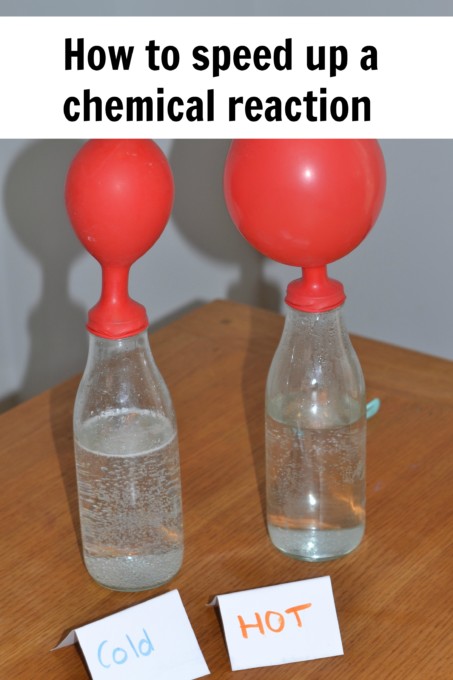Last week we tried a simple chemical reaction to investigate alka seltzer reacting with water. We’ve also observed the reaction between baking soda and vinegar before, both of which are very safe for even young children to observe.
Taking this a step further we’re going to investigate how to speed up a chemical reaction, while still keeping things very basic and easy to understand.
The nature of the reactants
Reactants are the two substances you combine to get the reaction. Some react slowly and some much faster depending on the bonds that need to be broken. For example, gold is very un-reactive, while sodium and potassium are so reactive that they tarnish instantly when exposed to the air.
Particle Size
The smaller the particles the faster the reaction, this is because there is a larger surface area available to react with the other substance.
Concentration
The higher the concentration, the faster the reaction, this is because there is more of the reactive substance available to react. We’ve observed this very simply in the past by adding more alka seltzer to a lava lamp which gives a bigger and faster reaction.
Temperature
The higher the temperature the faster the reaction, this is because if you heat up a substance the particles have more energy and move around faster meaning they have more contact with the other reactive substance.
We’ve designed a very simple experiment to demonstrate this using alka seltzer and hot and cold water.
Please be careful when trying this at home that the water you use isn’t too hot as it could spill out or burst the balloon, especially if you use a smaller container.
How to speed up a chemical reaction
This simple activity uses alka seltzer placed in hot and cold water to investigate where it reacts the fastest.
What to measure
The amount of carbon dioxide gas released in a certain time when the alka seltzer reacts with the water. We are measuring this by catching the gas in a balloon placed on top of the bottle containing water and alka selzer.
Things to keep the same
To make this investigation a fair test use the same size and type of container, the same amount of alka seltzer and water and the same amount of time allowed for the reaction to occur. These are the independent variables.
Things to change
The dependent variable ( the one we measure ) is the amount of gas produced.
You’ll need
2 small bottles
2 balloons
2 alka seltzer tablets
Warm water
Cold water
Instructions – rate of reaction experiment
Blow up each balloon and let the air out.
Half fill one container with warm water and one with cold water.
Drop half an alka seltzer into each container ( weigh them to make sure they are the same size )
Quickly place a balloon on top and compare the size of each balloon after 30 seconds and one minute.
Alternative ideas
Try crushing the alka seltzer and placing it inside the balloons. Place the balloons on top of the containers and lift them up so the alka selzer drops into the water when the balloon is already on top!
Compare the difference between rates of reaction with a half an alka seltzer in one piece and the same size but crushed.
Can you guess which of these four jars contained the warmest water?
Catalysts
A catalyst is a substance that speeds up a chemical reaction but is not changed itself by the reaction and can be used again. Examples of catalysts include platinum which is used in car exhausts to break down harmful emissions and yeast is a biological catalyst that speeds up the process of fermentation.
The opposite effect is demonstrated by food in a fridge, the cooler temperature slows down the reaction between oxygen and bacteria that makes the food spoil. Keeping your food fresher for longer.
Suitable for Key Stage 3 – Chemical Reactions
Last Updated on February 26, 2022 by Emma Vanstone


amazing idea! I did it for my sience experiment. Thank you so much
Can you right a conclusion about this experiment please.
Please mention everything about the whole experiment in the conclusion.
it’s for my sience fair.